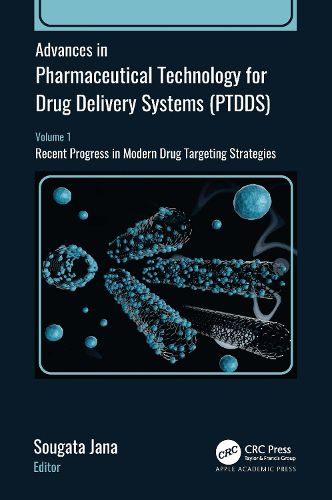Readings Newsletter
Become a Readings Member to make your shopping experience even easier.
Sign in or sign up for free!
You’re not far away from qualifying for FREE standard shipping within Australia
You’ve qualified for FREE standard shipping within Australia
The cart is loading…






In this new two-volume set, leading scientists focus on the recent progress in pharmaceutical technology for drug delivery systems and new drug targeting strategies. Each chapter covers a particular aspect of these delivery systems and relates the importance, fabrication technology, characterization, evaluation, therapeutic applications, and future perspectives by pharmaceutical scientists.
Volume 1: Recent Progress in Modern Drug Targeting Strategies covers a broad range of developments in drug delivery systems and drug targeting strategies. It discusses the challenges and the latest developments of the solid oral drug delivery system, the most common mode of drug delivery, and then provides a brief overview of the production, physico-chemical properties, formulations of microcarriers, nanotechnology, and liposomes as drug carrier systems. The volume covers transdermal drug delivery systems with a special focus on the management of skin diseases and looks at the use of hydrogels and polymeric micelle systems for drug delivery and biomedical applications. The emerging role of niosomes as candidate carriers in imaging and drug delivery is also explored. Other important technologies for drug delivery covered are polymer technologies featuring polymer grafting, interpenetrating polymer networks (IPN), and polyelectrolyte complex structures for controlled drug delivery.
Volume 2: Recent Progress in Biomedical Applications covers the role of niosomes as a convenient, cheap, and stable means of delivery of therapeutics in biomedical applications. It also looks at the uses of nanotechnology for drug delivery, including nanoencapsulation of bioactive compounds, genes in biological systems via nanotechnology-based techniques, and nanotechnology-based polymeric scaffolds in tissue engineering. Other technologies discussed include electrospun technology and 3D printing technologies in fabricating drug delivery systems. The book also dedicates a chapter to the use of natural biocarriers for brain targeting, a hereto difficult area for drug delivery.A graphene-based system for drug delivery is also discussed as are bio-ceramics systems.
The two volumes together provide a comprehensive review of the advanced research and development in drug delivery systems and drug targeting strategies technology.
$9.00 standard shipping within Australia
FREE standard shipping within Australia for orders over $100.00
Express & International shipping calculated at checkout
In this new two-volume set, leading scientists focus on the recent progress in pharmaceutical technology for drug delivery systems and new drug targeting strategies. Each chapter covers a particular aspect of these delivery systems and relates the importance, fabrication technology, characterization, evaluation, therapeutic applications, and future perspectives by pharmaceutical scientists.
Volume 1: Recent Progress in Modern Drug Targeting Strategies covers a broad range of developments in drug delivery systems and drug targeting strategies. It discusses the challenges and the latest developments of the solid oral drug delivery system, the most common mode of drug delivery, and then provides a brief overview of the production, physico-chemical properties, formulations of microcarriers, nanotechnology, and liposomes as drug carrier systems. The volume covers transdermal drug delivery systems with a special focus on the management of skin diseases and looks at the use of hydrogels and polymeric micelle systems for drug delivery and biomedical applications. The emerging role of niosomes as candidate carriers in imaging and drug delivery is also explored. Other important technologies for drug delivery covered are polymer technologies featuring polymer grafting, interpenetrating polymer networks (IPN), and polyelectrolyte complex structures for controlled drug delivery.
Volume 2: Recent Progress in Biomedical Applications covers the role of niosomes as a convenient, cheap, and stable means of delivery of therapeutics in biomedical applications. It also looks at the uses of nanotechnology for drug delivery, including nanoencapsulation of bioactive compounds, genes in biological systems via nanotechnology-based techniques, and nanotechnology-based polymeric scaffolds in tissue engineering. Other technologies discussed include electrospun technology and 3D printing technologies in fabricating drug delivery systems. The book also dedicates a chapter to the use of natural biocarriers for brain targeting, a hereto difficult area for drug delivery.A graphene-based system for drug delivery is also discussed as are bio-ceramics systems.
The two volumes together provide a comprehensive review of the advanced research and development in drug delivery systems and drug targeting strategies technology.